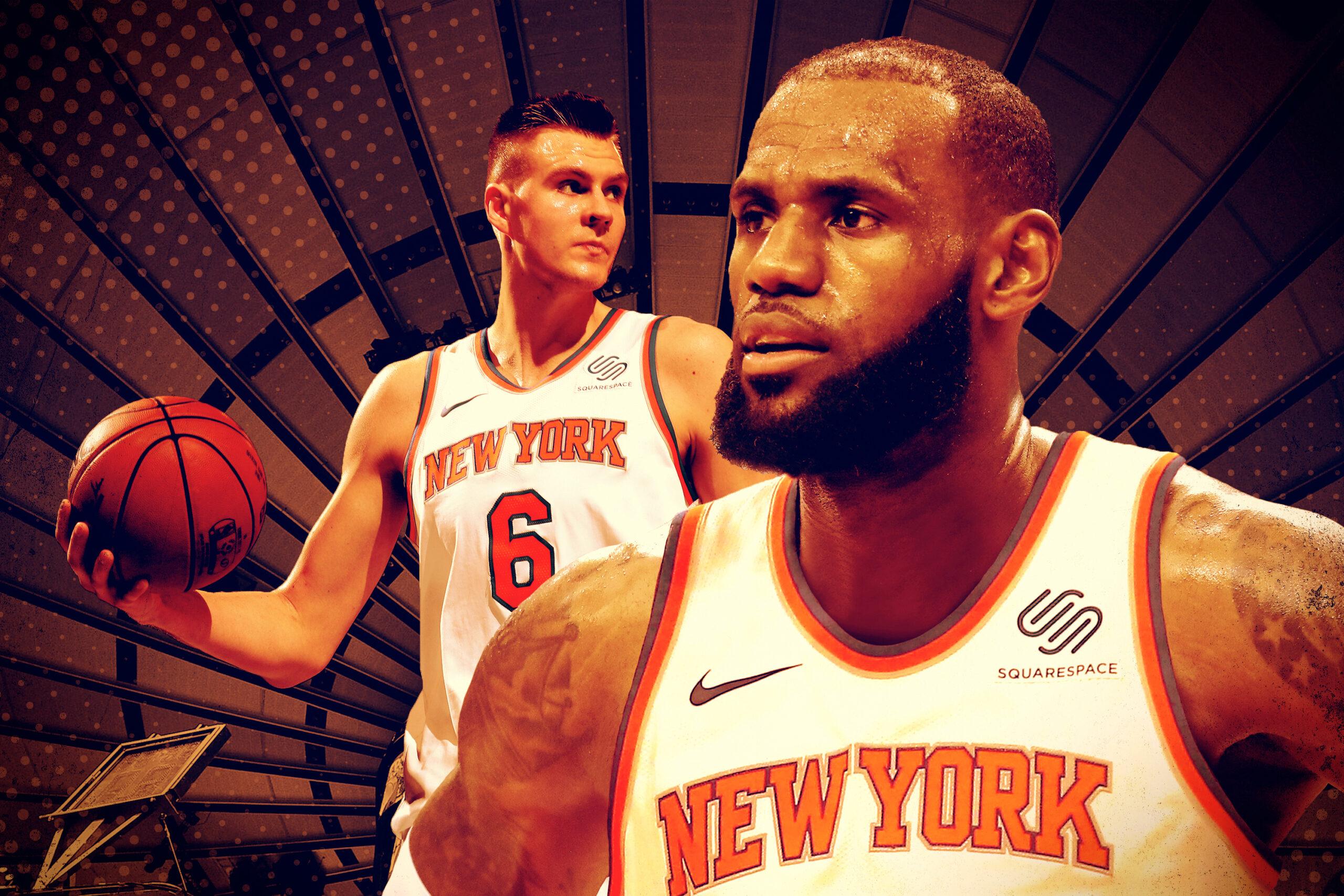
You don’t need a selfie-mode confessional to get a read on LeBron James’s current predicament. A sluggish performance in Dallas on Saturday was its own special kind of subtweet.
James’s minutes crept into the 40s for the sixth time in a season still three days shy of its one-month anniversary — against a team tied for the worst record in the league. As the Mavericks rallied in the fourth quarter, every made Dallas jumper and every Cavs turnover might as well have been accompanied by “Are you fucking kidding me?” in omniscient narration. The only times James seemed engaged late was when he spiked rookie Dennis Smith Jr.’s shot from behind with five minutes remaining and when he got a chance to embarrass Dirk Nowitzki, a 39-year-old made entirely of steel beams, on a switch in the final 75 seconds. His displeasure was even less subtle earlier in the game.
In the third quarter, ESPN’s Dave McMenamin overheard James instructing Jae Crowder on how to execute a simple catch-and-shoot. “When you catch the ball,” James barked, “have your feet already squared and be ready to shoot!”
In the second quarter, James literally stood and watched as Smith drove past Iman Shumpert.
The Cavs held on for the win, preventing a second straight weekend with an embarrassing loss to one of the worst teams in the NBA, but the message was clear: James is doing too much. He’s playing too much (a league-high 38.3 minutes per game, his most since his first season in Miami). He’s being relied on to score too much (28.5 points on 19 attempts per game, both highs since the 2009–10 season). And he’s not getting enough cover on defense (the Cavs allow 112 points per 100 possessions, by far the worst in the NBA).
The Kyrie Irving saga was unavoidable. But by trading away one of the league’s most dynamic scorers — and, perhaps more importantly, filling his role with an IOU at least until the new year — the Cavs only added to the burden of a 32-year-old star player prone to griping about his workload. This supporting cast is surely more talented than the scrubs with whom James finished his first Cleveland chapter — 33-year-old Antawn Jamison, 37-year-old Shaquille O’Neal, Anthony Parker, et al. But an older, thinner roster (especially when said old players can’t stay on the court) is a different kind of difficult for a player with 672 additional games on his odometer. Isaiah Thomas, health willing, can help, yet his return would make the roster only marginally better than the version of the team that lasted five games in a title bout against the Warriors last season.
But while it’s easy to stand, hands on hips, and marvel at the mess this Cavs team has become, it’s important to point out one of the main culprits of this malaise: LeBron James. This is the title-window life cycle James and the Cavs have effectively agreed to by approaching each new contract like a short-term business partnership. (How novel.) If anything, James’s lack of a firm commitment has forced the Cavs to hedge toward the future at the expense of the present. Cleveland, like Miami before it, will have a mess to clean up if and when James decides to hold any forthcoming championship parades elsewhere. James, meanwhile, is free to hunt for a younger vessel to tap into, like a blood boy, in order to maximize his winning potential. That’s the deal. And it works … until it doesn’t.
The Lakers are an obvious next destination for James for this very reason. There are advantages to starring for Los Angeles’s glamour team. He’d be closer to his other business interests and would have the built-in narrative to spin another yarn about saving a crestfallen franchise. But the biggest advantage the team possesses is the natural resources (loads of potential cap space and young assets) to construct another winner around James. His camp has already begun trumpeting as much. “These days, it doesn’t matter anymore. The Lakers and the Knicks have been bad — the Knicks for a very long time, the Lakers since Kobe aged out of being one of the best players in the league,” Maverick Carter, James’s friend and business partner, said recently. “You can be known or be a star from anywhere — anywhere in the world. … When you win as an athlete, that matters the most.”
But winning and playing for a big-market team aren’t mutually exclusive. They just might not be targeting the right one.
Every game LeBron James played at Madison Square Garden leading up to the summer of 2010 was treated with the pomp of a royal decree. It’s all so hard to comprehend now, when Banana Boaters are all but LOLing at the idea and free agents are holding their noses before accepting James Dolan’s money, but some New Yorkers treated James’s impending arrival like a prophecy etched into Babe Ruth’s bat. Even Tony Soprano had takes.
Now, comments like the ones James made about Dennis Smith Jr. on his way out of Dallas barely ripple. “The Knicks passed on a really good one, and Dallas got the diamond in the rough,” James said. “He should be a Knick. That’s going to make some headlines, but he should be a Knick.”
The most common reading of James’s impromptu draft analysis is of one final helping of shade for Phil Jackson, whom James TKO’d last November. But the one good decision Jackson made should be the one James is most interested in.
Kristaps Porzingis is, in an objective sense, really, really good. In 11 games since the surgical removal of both Jackson and Carmelo Anthony, the 22-year-old is averaging 30.4 points (second in the NBA), 7.3 rebounds, and 2.3 blocks (third), with a 61.4 true shooting percentage. When he walks into Monday’s matchup against the Cavs, Porzingis’s PER (30.63) will be higher than even James’s (29.86), and bested by only Giannis Antetokounmpo’s (32.75). I have probably inhaled too much secondhand KP love from The Ringer’s NBA Slack to be trusted, but considering he is still on a rookie contract through next season, it now seems perfectly reasonable to argue that Porzingis represents the most valuable contract in the NBA. In other words, he is the perfect player to help James ease into his golden years.
That last part is important. James’s professional twilight will probably be subjected to a Spursian last rites/mea culpa vicious cycle, but now, amid his 15th NBA season, feels like a good time to start preparing for a reality in which he is no longer the best player on the floor. Ideally, that player would play for the same team. Paul George will be 28 by next offseason, when the Lakers will attempt to execute the vision of grandeur Rob Pelinka saw in the haze of a hot yoga class. But while George has had moments playing next to Russell Westbrook, especially of late, questions still remain about his ability to ascend to the first chair, and whether he’s willing to leave Westbrook’s side in the first place. And either Brandon Ingram or Lonzo Ball, or both, will have to make good on the hype and also do it fast enough to match LeBron’s timeline.
Porzingis is — deep breath — closer to a sure thing. He is already worthy of the superstar title, with a rare blend of rim protection, skill, and shooting that should let him excel alongside James. He presents an effective counter to teams built on size or shooting or both, spares James from possibly sliding down to de facto center on a more wing-heavy roster, and may even ease the burden of constructing a team around them. A 4–5 pick-and-pop surrounded by entry-level shooters and cutters would be a potentially lethal midsize version of what Anthony Davis and DeMarcus Cousins have effectively deployed this season in New Orleans. James has played with two of the elite stretch bigs of his generation, but not even Chris Bosh had the ceiling Porzingis has flashed thus far. LeBron and Kristaps would be a modern-day Magic and Kareem, all under the lights of what is probably still basketball’s most hallowed stage. That would be a special experience for all NBA fans.
Dreaming is easy. The hard part is everything else. For starters, the Knicks’ cap sheet is nothing but fire and brimstone. Not even the Trade Machine could suspend reality enough to clear an easy path for James, let alone another high-level running mate along with him, with three contracts in excess of $17 million likely on the books for next season. My best shot involves James opting into to the final year of his contract and the Cavs, in a bid to salvage a future, flipping him for a package centered around Enes Kanter’s expiring contract (the final year of which he will almost certainly opt into), Frank Ntilikina (I’m so sorry, everyone), Willy Hernangomez, the Knicks’ 2018 first-rounder, maybe another pick, and some salary filler. Shades of the original-sin Melo trade with Denver abound, but Melo is hardly LeBron in terms of value.
Then there’s the issue of the organization itself. While the team president is no longer baiting its best player (who also happens to be a close, personal friend of James), the Knicks hardly started fresh this summer. Scott Perry has taken over as GM, while Steve Mills and a toxic workplace culture persist. But though Jackson’s tenure proved to be another disaster in a long, sordid history of them, Dolan’s concession of power to Jackson in the first place was, and remains, a much-needed step in the right direction. The issue is finding the right people to empower. To that end, I ask: Why not Team James?
In an interview with The Athletic last May, James was adamant that he would eventually own an NBA team. “That’s my next thing,” he told Ken Berger. Though active players are barred by league rules from ownership, the Knicks can still offer James a gateway for after he retires. Sell a minority share (1 percent or less) of the franchise to Carter and Randy Mims, another James confidant. While you’re at it, lure Rich Paul away from Klutch Sports and install him as the newest agent turned GM. For James, who has fiercely protected and prioritized his personal agency in recent years, the arrangement would essentially give him a seat at the table of a franchise with one of the furthest reaches in sports. Adam Silver, who’s already putting his approval rating at risk with his recent comments on the national anthem, would need to take the L here and allow what is essentially a thinly veiled skirting of antitrust laws rather than incite his most prominent supporter. Dolan, meanwhile, would make a few enemies in ownership circles, but in one fell swoop would wash away the stench of decades of mismanagement. Maybe Chris Paul would consider playing for Team James at a discount. Maybe Melo would be welcomed back to close his Knicks chapter on more favorable terms.
One Knicks fan close to the perpetually miserable situation, when broached on this master plan, expressed reservation. Why, he posited, would the Knicks throw away the precious coffer of draft picks — and derail a slow, well-reasoned rebuild — for the declining seasons of another aging superstar, even if he is one of the best in history?
First of all, 12 games are a helluva drug. Second, he’s not exactly wrong. The LeBron-era Knicks would likely need to mortgage the foreseeable future just to assure conference-title contention in Year 1. One can argue that Porzingis’s ascension might also make them too good to land a second star via the draft in the final season before the new tank-chilling rules kick in. But eschewing the first sign of prudence in decades for what is, in a broad sense, the same old get-rich-quick scheme is a tough sell to a fan base clearly stricken with Dolan-induced trauma.
On the other hand, there would be a LeBron era in Knicks history.
Sign me up.

